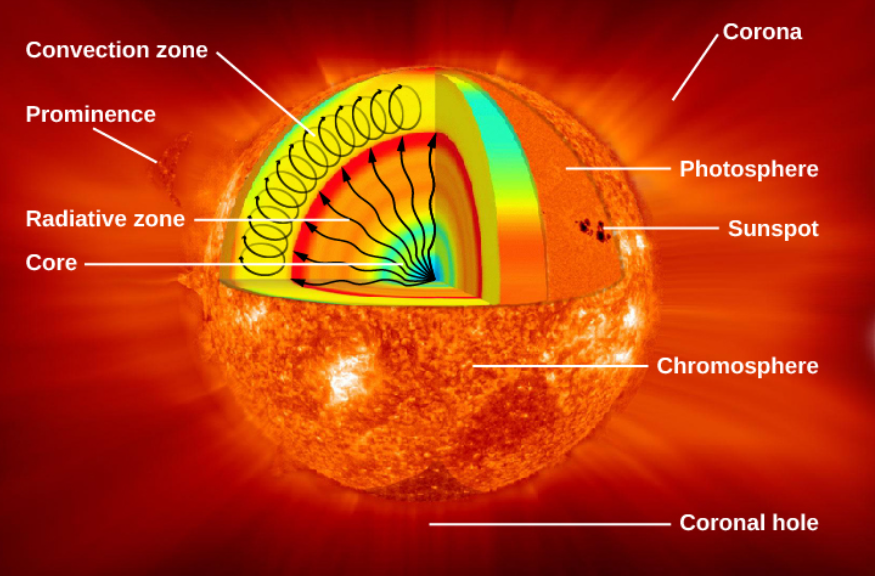chapter 15.1; the structure and composition of the Sun
1/13
There's no tags or description
Looks like no tags are added yet.
Name | Mastery | Learn | Test | Matching | Spaced |
|---|
No study sessions yet.
14 Terms
features of the Sun
does not have a solid surface or continents
does not have a solid core
Sun’s makeup is quite typical of stars
sun’s temperature mean many of the atoms are ionised (stripped of one or more of their electrons)
means there is a large quantity of free electrons and positively charged ions in the Sun (the Sun this thus an electrically charged environment)
hot ionised gas: plasma
composition of the sun’s atmosphere
73% Sun’s mass = hydrogen
25% Sun’s mass = helium
2% Sun’s mass = oxygen, nitrogen, carbon
most of the elements found in the Sun are in the form of atoms, all in gas form
sun’s temperature mean many of the atoms are ionised (stripped of one or more of their electrons)
layers of the Sun


sun’s core
extremely dense
source of all the sun’s energy
nuclear energy is released
approx. 20% of the size of the solar interior
temperature of 15 million K
hottest part of the Sun
radiative zone
named for the primary mode of transporting energy across it
stars at 25% of the distance to the solar surface and extends up to about 70% of the way to the surface
ight generated at the core is transported through the radiative zone very slowly, since the high density of matter in this region means a photon cannot travel too far without encountering a particle, causing it to change direction and lose some energy
convective zone
outermost layer of the solar interior
thick layer of approx. 200,000km deep that transports energy from the edge of the radiative zone to the surface through giant convection cells
the plasma at the bottom of the convective zone is extremely hot, and it bubbles to the surface where it loses its heat to space
once the plasma cools, it sinks back to the bottom of the convective zone
solar photosphere
layer where the Sun becomes opaque and marks the boundary past which we cannot see
temperature of approx. 5800K
energy that emerges from the photosphere was originally generated deep inside the Sun
this energy is in the form of photons, which make their way slowly toward the solar surface
outside the Sun, we can only observe those photos that are emitted into the solar photosphere (density of atoms is sufficiently low and the photos can escape without colliding)
the thin region in which the solar atmosphere changes from almost transparent to almost opaque in a distance of just over 400km
at a typical point of the photosphere, the pressure is less than 10% of Earth’s pressure at sea level, and the density is about 1/10,000 of Earth’s atmospheric density at sea level
granulation of photosphere
photosphere has a mottled appearance
granulation
granules (700-1000km in diameter)
lifetime of each granule is 5-10 minutes
supergranules (35,000km diameter) last about 24 hours
motion of granules can be studied by examining the Doppler shifts in the spectra of gases just above them
the bright granules are columns of hotter gases rising at speeds of 2 to 3 kilometers per second from below the photosphere
As this rising gas reaches the photosphere, it spreads out, cools, and sinks down again into the darker regions between the granules
Measurements show that the centers of the granules are hotter than the intergranular regions by 50 to 100 K.
chromosphere
region of the Sun’s atmosphere that lies immediately above the photosphere
visible when the photosphere is concealed by the Moon during a total solar eclipse
2000-3000km thick
10,000K
spectrum consists of bright emission lines; this layer is composed of hot gases emitting light at discrete wavelengths
The reddish color of the chromosphere arises from one of the strongest emission lines in the visible part of its spectrum - the bright red line caused by hydrogen
transition region
the part of the Sun where rapid temperature rise occurs between the chromosphere to the corona
corona
temperature of >1 million degrees
outermost part of the Sun’s atmosphere
can be observed during a total eclipses
extends millions of kms above the photosphere and emits about half the light of a full moon
very low density
10^90 atoms per m³
solar wind
Sun’s atmosphere produces a stream of charged particles (mainly protons and electrons)
the particles flow outward from the Sun into the solar system at a speed of about 400km/s
exists because the gases in the corona are so bot and moving so rapidly that they cannot be held back by solar gravity
Sun loses about 1-2 million tons of material each second through this wind
coronal holes
large dark regions of the corona that are relatively cool and quiet
magnetic field lines stretch far out into space away from the Sun, rather than looping back to the surface
solar wind comes predominantly from coronal holes, where gas can stream away from the Sun into space unhindered by magnetic fields
auroras
charged particles accelerated by the solar wind can follow the field down into our atmosphere
as the particles strike molecules of air, they case them to glow, producing curtains of light (auroras) (northern and southern lights)